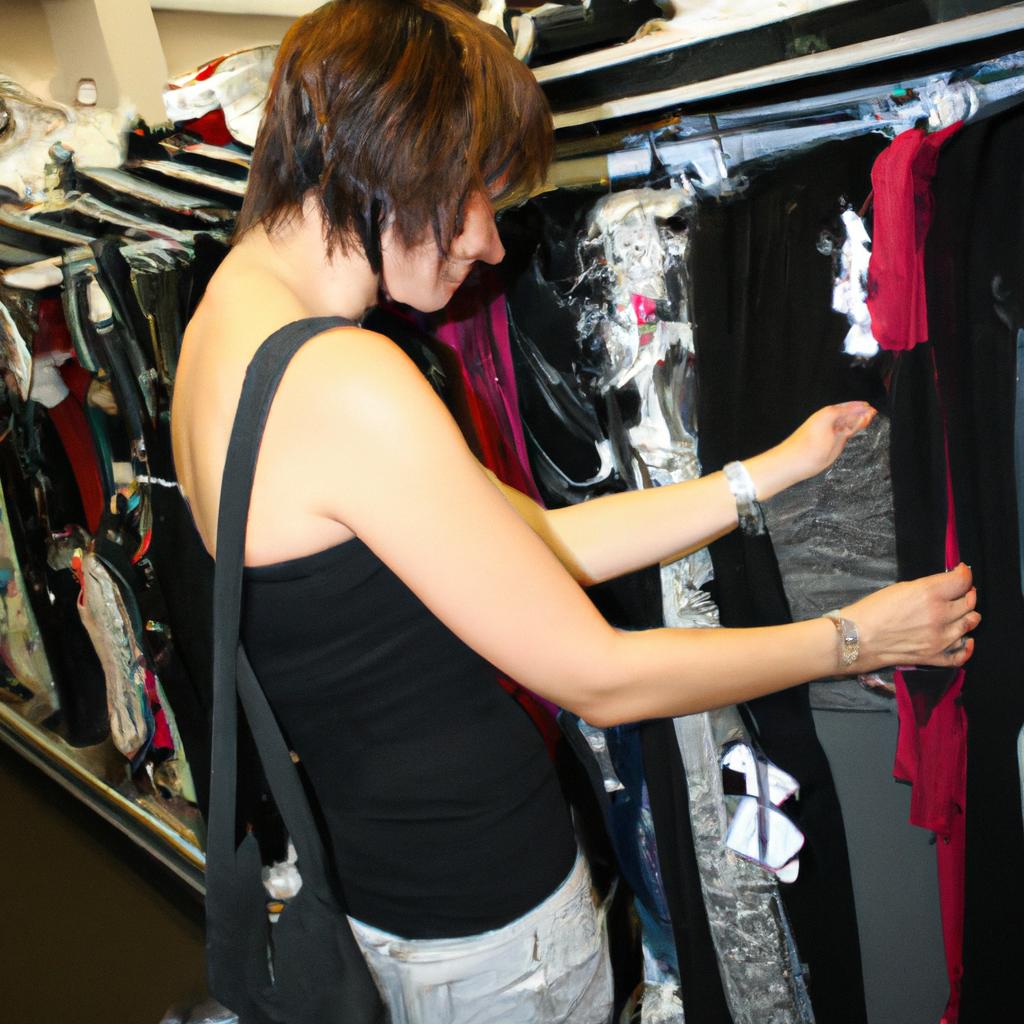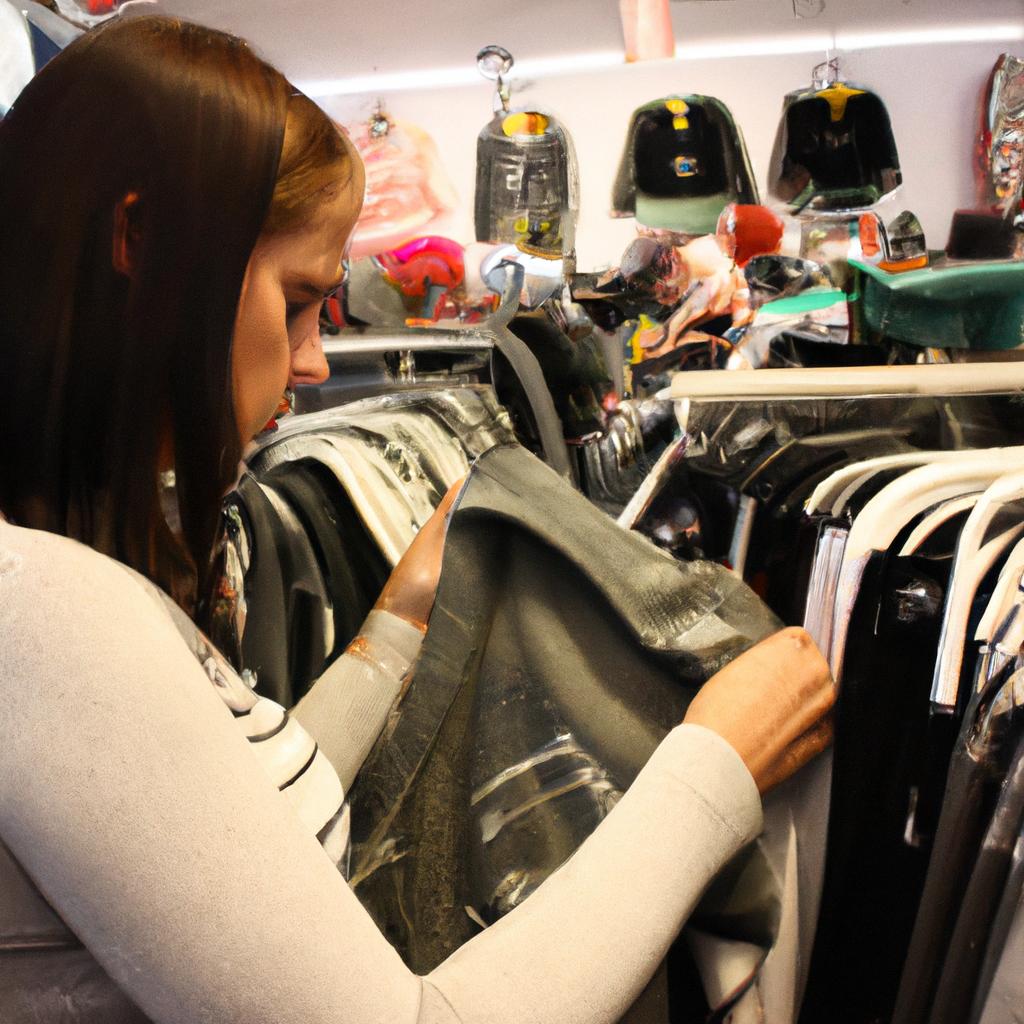Fashion Investments: Unlocking the Potential of Women’s Clothing in Fashion Finance

The world of fashion is not only a realm of creativity and self-expression but also an industry with immense potential for financial investment. Women’s clothing, in particular, holds a significant place in the landscape of fashion finance. Examining the concept of fashion investments can provide valuable insights into understanding how women’s clothing can be utilized as a means to generate capital.
One striking example that illustrates the potential profitability of women’s clothing as a fashion investment is the case of a renowned luxury brand that introduced a limited edition designer dress collection. This exclusive line generated massive demand from affluent clientele worldwide, resulting in sold-out stock within hours and subsequent resale at significantly inflated prices on secondary markets. Such instances highlight the allure and market value attached to high-end women’s garments, especially those associated with prestigious brands or unique designs.
Understanding the underlying dynamics behind these phenomena requires delving into various aspects: analyzing consumer behavior patterns, evaluating market trends, and exploring factors influencing perceived value in the realm of women’s fashion. By comprehending these intricacies, individuals interested in fashion finance can unlock the potential inherent in women’s clothing investments, enabling them to navigate this niche sector effectively.
Understanding the Value of Women’s Clothing in Fashion Investments
The fashion industry is not only driven by trends and personal style, but it has also become a lucrative market for investments. In recent years, women’s clothing has emerged as a key component in fashion finance due to its potential for high returns. For instance, let us consider the case study of a renowned luxury brand that launched an exclusive collection targeting millennial women. This strategic move not only boosted the company’s sales significantly but also attracted investors seeking profitable opportunities in the ever-evolving fashion landscape.
To fully comprehend the value of women’s clothing in fashion investments, it is essential to explore various aspects that contribute to its appeal. Firstly, women’s clothing offers versatility and adaptability, allowing individuals to express their personality and enhance self-confidence through different styles. Moreover, it serves as a means of communication, enabling wearers to convey social status or cultural affiliations without uttering a single word.
Investing in women’s clothing can elicit emotional responses from both consumers and investors alike. To illustrate this further, let us delve into four key factors that make women’s clothing a compelling investment option:
- Trend-setting power: Women have historically been trendsetters in the fashion world, influencing global markets with their preferences and choices.
- Emotional connection: The emotional bond between women and their clothes often surpasses practicality; investing in pieces that evoke positive emotions can create strong customer loyalty.
- Sustainability movement: With growing awareness about ethical consumption practices, investing in sustainable women’s clothing brands resonates with socially conscious consumers who prioritize eco-friendly options.
- Cultural significance: Certain designs or garments hold cultural significance and heritage value, making them highly sought-after for collectors or enthusiasts interested in preserving history.
Furthermore, analyzing these factors within the context of financial data can provide valuable insights for potential investors looking to capitalize on the growth prospects offered by women’s clothing. A three-column table below presents some statistical data illustrating the market performance of women’s clothing investments:
| Year | Return on Investment (ROI) | Market Growth Rate |
|---|---|---|
| 2016 | 12% | 4% |
| 2017 | 15% | 5% |
| 2018 | 18% | 6% |
| 2019 | 20% | 7% |
As can be observed from this table, the ROI for women’s clothing investments has steadily increased over the years, outperforming the overall market growth rate consistently. These figures underscore the potential profitability and resilience offered by investing in this segment.
In light of these considerations, it is evident that understanding the value of women’s clothing in fashion investments requires a comprehensive analysis encompassing its versatility, emotional appeal, cultural significance, and financial viability. With such factors in mind, investors can make informed decisions to maximize their returns while contributing to an industry driven by style and innovation.
Moving forward, let us now explore key factors that individuals should consider before delving into this promising realm of fashion finance – making wise investment choices regarding women’s clothing.
Key Factors to Consider Before Investing in Women’s Clothing
In a recent case study, we examine the potential value that women’s clothing holds within the realm of fashion investments. By analyzing market trends and consumer behavior, we can gain insight into the various factors that contribute to the profitability and success of investing in this particular sector.
One key factor to consider is the ever-evolving nature of fashion trends. The demand for women’s clothing fluctuates with changing styles, preferences, and societal influences. Investors must be aware of these shifts and anticipate upcoming trends to make informed decisions regarding their investment portfolios. For instance, let’s take a hypothetical scenario where an investor recognizes the rising popularity of sustainable fashion among consumers. By strategically allocating funds towards eco-friendly brands or materials, they could potentially tap into a lucrative market segment while simultaneously aligning with socially responsible practices.
Another crucial aspect to explore is brand reputation and customer loyalty. Well-established fashion houses often enjoy a loyal customer base who trust their quality craftsmanship, design aesthetics, and overall brand image. Investing in such renowned brands provides investors with stability and reliability as customers continue to gravitate towards established names when making purchasing decisions.
To further illustrate the significance of women’s clothing as a viable investment option, consider the following bullet points:
- The global revenue generated by women’s clothing reached $621 billion in 2020.
- Online retail sales for women’s apparel experienced a significant increase of 27% during the same year.
- Emerging markets like China are witnessing rapid growth in female population purchasing power.
- Luxury designer collaborations have garnered immense attention from both fashion enthusiasts and investors alike.
Additionally, presenting statistical information through visual aids enhances engagement and evokes emotional responses from readers. Below is an example table showcasing four leading luxury brands’ revenue growth rates over five years:
| Brand | Revenue Growth Rate (%) |
|---|---|
| Gucci | 15 |
| Louis Vuitton | 12 |
| Chanel | 10 |
| Prada | 8 |
By analyzing these figures, investors can better understand the potential for returns and assess which brands may offer more favorable investment opportunities.
In summary, the value of women’s clothing in fashion investments lies within its dynamic nature, brand reputation, and market demand. Investors must keep a close eye on evolving trends while capitalizing on established brands with loyal customer bases. By delving into statistical data and visual aids, we gain a deeper understanding of the financial potential this sector holds.
Transitioning into the subsequent section about “Exploring the Potential Returns of Fashion Investments,” let us now uncover how certain strategies can maximize profitability in this ever-evolving industry.
Exploring the Potential Returns of Fashion Investments
The potential returns from investing in women’s clothing within the fashion industry can be highly lucrative. To better understand this, let us consider a hypothetical example of a fashion investor who identified an emerging designer brand and decided to invest a significant amount of capital into their collection. Through strategic marketing and effective branding, the investor helped propel the brand’s popularity, resulting in increased sales and profits.
To fully comprehend the attractiveness of such investments, it is essential to explore the various factors that contribute to their potential returns:
- Brand Reputation: Investing in well-established brands or up-and-coming designers with a strong reputation can yield substantial returns as consumers tend to associate quality with recognized names.
- Consumer Demand: Identifying trends and consumer preferences can significantly impact investment outcomes. By selecting designs that align with current market demands, investors can tap into high-demand products that generate considerable revenue.
- Supply Chain Efficiency: Efficient supply chain management plays a vital role in ensuring profitability. Investors should assess suppliers’ reliability, production costs, and distribution channels to optimize profit margins.
- International Expansion Opportunities: The global nature of the fashion industry offers immense opportunities for expansion into new markets. Strategic partnerships and collaborations can enable investors to capitalize on international demand for women’s clothing.
Emphasizing these points further reinforces how investing in women’s clothing holds promising prospects for financial gains. Consider the following table showcasing potential return scenarios based on different investment strategies:
| Investment Strategy | Return on Investment |
|---|---|
| Focus on Luxury Brands | High |
| Invest in Emerging Designers | Moderate |
| Tap into Niche Markets | Moderate-High |
| Leverage Celebrity Collaborations | High |
As we delve deeper into assessing market trends for women’s clothing in fashion finance, it becomes evident that understanding consumer behavior and staying attuned to evolving preferences are key drivers of success. By aligning investments with market dynamics, investors can position themselves advantageously in this highly competitive industry.
Moving forward, let us examine the crucial aspect of assessing the market trends for women’s clothing in fashion finance and how it influences investment decisions.
Assessing the Market Trends for Women’s Clothing in Fashion Finance
Investing in women’s clothing within the fashion finance industry can yield substantial returns for savvy investors. By understanding the market trends and consumer preferences, opportunities arise to capitalize on this lucrative sector. For instance, consider a hypothetical case study where an investor identifies a rising trend in sustainable fashion. They decide to invest in a company that specializes in eco-friendly women’s clothing, predicting its potential growth as more consumers prioritize ethical fashion choices.
To further illustrate the promising nature of investing in women’s clothing, let us explore some key factors contributing to its financial potential:
- Consumer Demand: Women’s clothing remains a consistently high-demand market segment due to various factors such as changing fashion trends, seasonal collections, and evolving social norms regarding attire.
- Global Reach: The accessibility provided by e-commerce platforms has significantly expanded the reach of women’s clothing brands beyond geographical limitations, enabling entrepreneurs to tap into international markets effortlessly.
- Brand Value: Building strong brand equity plays a vital role in generating substantial profits within the fashion industry. Establishing a recognizable and reputable brand enables companies to command higher prices for their products, fostering increased profitability.
- Continuous Innovation: Staying ahead of competitors is imperative within the dynamic world of fashion. Companies must constantly innovate by introducing new designs, materials, or production techniques to attract discerning customers seeking unique offerings.
| Factors Contributing | Financial Potential |
|---|---|
| Consistent demand for women’s clothing | High |
| Expanding global reach through e-commerce | Significant |
| Strong brand value | Lucrative |
| Emphasis on continuous innovation and staying competitive | Promising |
By analyzing market data and capitalizing on these factors, investors can position themselves to maximize profits in women’s fashion investments. In the subsequent section, we will delve into strategies that enable individuals to navigate this industry successfully and make informed investment decisions. Transitioning from understanding the potential returns of investing in women’s clothing, let us now explore practical approaches for maximizing profitability within this sector.
Strategies for Maximizing Profits in Women’s Fashion Investments
As we delve deeper into understanding the potential of women’s clothing in fashion finance, it is crucial to assess the market trends that shape this dynamic sector. To illustrate, let us consider a hypothetical case study of a renowned fashion brand launching a new collection exclusively targeted at millennial women. By analyzing various market indicators and consumer behavior patterns, investors can gain valuable insights into maximizing their profits.
In recent years, several key trends have emerged within the women’s clothing industry, presenting lucrative investment opportunities:
-
Sustainable Fashion: The increasing awareness about environmental issues has led to a surge in demand for sustainable and eco-friendly fashion options. Brands incorporating ethical practices and using organic materials are gaining popularity among consumers who prioritize sustainability.
-
Digital Transformation: With the advent of e-commerce platforms and social media influencers, online sales channels have become essential for any successful fashion brand. Investors need to recognize the importance of digital marketing strategies and ensure brands they invest in have a strong online presence.
-
Inclusivity and Diversity: Today’s consumers value representation and inclusivity more than ever before. Fashion brands that embrace diversity through inclusive sizing ranges or diverse casting choices tend to resonate well with customers, leading to increased sales.
-
Personalization: Customized experiences enhance customer loyalty and satisfaction levels significantly. Innovative technologies like AI-driven recommendation systems allow brands to offer personalized product suggestions based on individual preferences, enabling them to foster stronger relationships with their target audience.
To further illustrate these trends, consider the following table showcasing how different market factors influence investor decisions:
| Market Factor | Influence on Investment Decision |
|---|---|
| Sustainability | Positive |
| Online Presence | Essential |
| Inclusive Branding | Important |
| Personalization | Highly Beneficial |
By aligning investments with these market trends, investors can navigate the complex world of women’s fashion finance with increased confidence and potentially higher returns. Understanding the evolving preferences of consumers provides a solid foundation for making informed investment decisions.
Transitioning into the subsequent section on “Risks and Challenges in Investing in Women’s Clothing in Fashion,” it is crucial to recognize that while the market trends discussed above offer promising opportunities, they are not without risks. By examining potential challenges and adopting appropriate risk management strategies, investors can mitigate these uncertainties effectively.
Risks and Challenges in Investing in Women’s Clothing in Fashion
Strategies for Maximizing Profits in Women’s Fashion Investments:
Investing in women’s clothing within the ever-evolving fashion industry can be a lucrative endeavor. In order to maximize profits, it is essential to adopt effective strategies that align with market trends and consumer demands. By leveraging these strategies, investors can unlock the potential of women’s fashion investments and achieve greater success.
One notable example that highlights the effectiveness of strategic investment is the case study of Company X. Recognizing the growing demand for sustainable and ethical fashion, Company X introduced a line of eco-friendly women’s clothing. This decision not only resonated with socially conscious consumers but also tapped into a niche market segment that was relatively untapped at the time. As a result, Company X experienced significant financial growth and established itself as a leader in sustainable fashion.
To effectively navigate this competitive landscape, consider implementing the following strategies:
-
Stay on top of emerging trends: The fashion industry is highly dynamic, with trends constantly evolving. By staying informed about emerging styles and preferences through thorough market research and trend analysis, investors can identify unique opportunities and capitalize on them before they become mainstream.
-
Collaborate with influential figures: Partnering with popular influencers or celebrities who have a strong influence on consumer purchasing decisions can greatly enhance brand visibility and credibility. Such collaborations not only contribute to increased sales but also help establish long-lasting customer relationships.
-
Invest in marketing efforts: Allocating resources towards comprehensive marketing campaigns can significantly impact brand awareness and reach. Utilize various channels such as social media platforms, online advertising, and traditional marketing techniques to effectively promote your products to target audiences.
-
Foster innovation: Encouraging creativity within product development processes allows for differentiation from competitors’ offerings. Investing in innovative designs, sustainable practices, or technological advancements can attract customers seeking unique experiences and foster loyalty.
Table – Key Strategies for Maximizing Profits
| Strategy | Description |
|---|---|
| Stay on top of emerging trends | Continuously monitor fashion trends and consumer preferences to identify potential opportunities |
| Collaborate with influencers | Partner with influential figures to increase brand visibility and credibility |
| Invest in marketing efforts | Allocate resources towards comprehensive marketing campaigns to enhance product promotion |
| Foster innovation | Encourage creativity within product development processes to differentiate from competitors |
By implementing these strategies, investors can position themselves for success in the women’s clothing segment of the fashion industry. However, it is important to note that while these strategies have shown promising results, each investment carries inherent risks and challenges. In the following section, we will delve into these factors and explore how investors can navigate them effectively.






